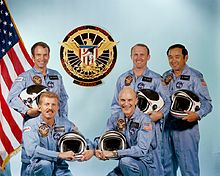 Discovery in orbit; in-flight photography of the Department of Defense support mission is limited. | |
| Names | Space Transportation System-15 |
|---|---|
| Mission type | DoD satellite deployment |
| Operator | NASA |
| COSPAR ID | 1985-010A |
| SATCAT no. | 15496 |
| Mission duration | 3 days, 1 hour, 33 minutes, 23 seconds |
| Distance travelled | 2,010,000 km (1,250,000 mi) |
| Orbits completed | 49 |
| Spacecraft properties | |
| Spacecraft | Space Shuttle Discovery |
| Launch mass | 113,802 kg (250,890 lb) |
| Landing mass | (Classified) |
| Payload mass | (Classified) |
| Crew | |
| Crew size | 5 |
| Members | |
| Start of mission | |
| Launch date | January 24, 1985, 19:50:00 UTC (2:50 pm EST) |
| Launch site | Kennedy, LC-39A |
| Contractor | Rockwell International |
| End of mission | |
| Landing date | January 27, 1985, 21:23:23 UTC (4:23:23 am EST) |
| Landing site | Kennedy, SLF Runway 15 |
| Orbital parameters | |
| Reference system | Geocentric orbit[1] |
| Regime | Low Earth orbit |
| Perigee altitude | 332 km (206 mi) |
| Apogee altitude | 341 km (212 mi) |
| Inclination | 28.45° |
| Period | 91.30 minutes |
 STS-51-C mission patch  Back row: Payton, Buchli and Onizuka Front row: Shriver and Mattingly | |
STS-51-C (formerly STS-10) was the 15th flight of NASA's Space Shuttle program, and the third flight of Space Shuttle Discovery. It launched on January 24, 1985, and made the fourth shuttle landing at the Shuttle Landing Facility at the Kennedy Space Center in Florida on January 27, 1985. STS-51-C was the first shuttle mission dedicated to the United States Department of Defense (DoD), and consequently many details remain classified. NASA reported that a satellite (USA-8) was deployed during the mission using an Inertial Upper Stage booster was deployed and met mission objectives. At just over three days, the mission was shorter in duration than most civilian missions and was the shortest of Discovery's career.